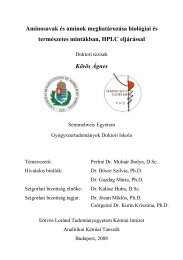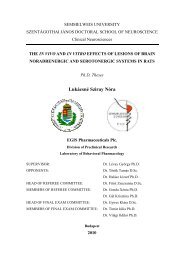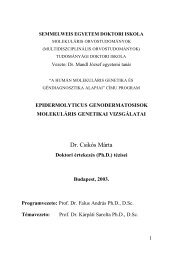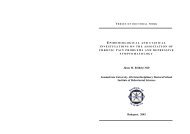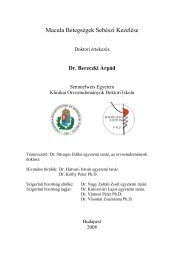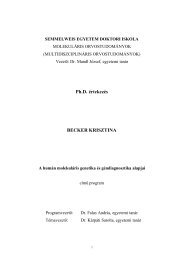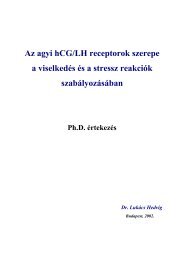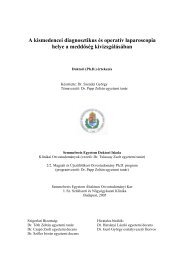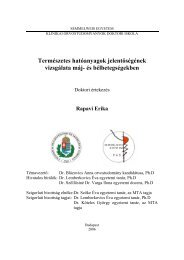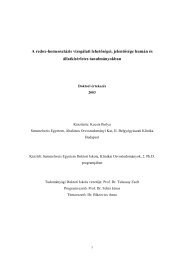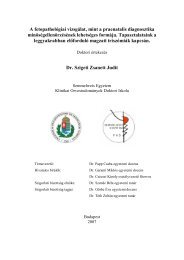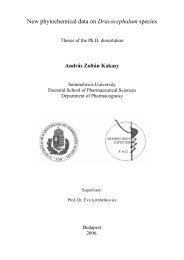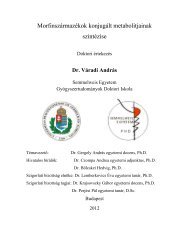GLYCOSIDES IN Viola Tricolor L.
GLYCOSIDES IN Viola Tricolor L.
GLYCOSIDES IN Viola Tricolor L.
Create successful ePaper yourself
Turn your PDF publications into a flip-book with our unique Google optimized e-Paper software.
CHAPTER 2: <strong>IN</strong>TRODUCTION<br />
Todifferentiatebetweentheisomers,twobasicmethodshavebeendescribed.<br />
On one hand, they can be distinguished by their product ion spectra, through<br />
the analysis of the Y1, Y0, and Z1 ions. The presence ofthe Z1 fragment implies<br />
that one sugar unit is linked to another sugar and not directly to the aglycone,<br />
therefore indicates an O- or C,O-diglycosyl structure [96, 98, 106]. In addition,<br />
differences were observed in the relative abundancesofthe Y −<br />
1<br />
and Y−<br />
0<br />
ions for<br />
thetwoO-glycosyl isomerforms. Fordi-O-glycosides,theY −<br />
1 ionwasreported<br />
tobethebasepeak(100%relativeabundance),andtheY −<br />
0 ofmediumintensity<br />
(about 30% relative abundance), whilst in the spectra of O-diglycosides the Y −<br />
0<br />
ion exhibited the highest abundance (Fig. 2.8) [106]. Analogously, for di-C,O-<br />
glycosides, the Y −<br />
0<br />
case of C,O-diglycosides, the Y −<br />
0<br />
theZ −<br />
1<br />
observably exhibited the highest abundance, whereas in the<br />
showed less than 10 % relative intensity, and<br />
fragmentwasfoundtobethebasepeak[96]. Theothermethodisbased<br />
on the presence of characteristic radical ions. The product ion spectra of di-<br />
O-glycosides contained [Y1–H] −• radical ions and a [Y0–2H] − fragment. In the<br />
spectra of O-diglycosides only the [Y0–H] −• radical ion was observed, the [Y1–<br />
H] −• ionsweremissing,asitwasdemonstratedforflavonolglycosides(Fig.2.9a<br />
and b) [104]. Similarly, the [Y1–H] −• ion was typically observed upon cleavage<br />
oftheglycosidicbondbetweentheaglyconepartandtheO-linkedglycan,thus<br />
only forthe di-C,O-glycosyl flavoneisomer [113].<br />
Apparently,thedeterminationofthesugarunitdistributionwouldbeeasier<br />
inthecaseofglycosideswithdifferentsugarunits. Asafirstapproximation,the<br />
product ion spectra of di-O-glycosides would contain two Y1 + ions at different<br />
m/z values, whereas in the spectra of O-diglycosides only one Y1 + fragment<br />
would be observed, corresponding to the loss of the external sugar unit. In<br />
the product ion spectra of O-diglycosides, however, a second Y1 + ion was also<br />
reported–usuallylabeledasY ∗ –,originatingfromthelossoftheinternalsugar<br />
residue making spectra interpretation misleading[108].<br />
Glycan sequence Thisstructural characteristic isonly relevantfor glycosides<br />
withdifferentsugarunitsanddeterminationoftheglycansequenceseemsself-<br />
explanatory [98]. For example, in the product ion spectra of O-diglycosides,<br />
theY1(externalsugar) andY0 fragmentswereexpected. However,asitwasdemon-<br />
strated on the example of rutin (quercetin-3-O-rhamnosyl(1→6)glucoside), the<br />
negative ion MS/MS spectra of (1→6) diglycosides often did not show signif-<br />
25



